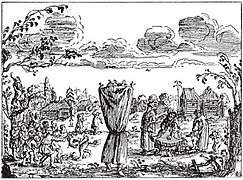Tame bear

A tame bear, often called a dancing bear, is a wild bear captured when the animal was young, or born and bred in captivity, and used to entertain people in streets or taverns. Dancing bears were commonplace throughout Europe and Asia from the Middle Ages to the nineteenth century, and could still be found in the 21st century in some countries.
Dancing bears
History
Dancing bears were commonplace in the Indian subcontinent for centuries. The last of them were freed in 2009.[1] Romani people from Saudi Arabia traditionally poached Syrian brown bear cubs from mountainous regions of Syria, Turkey, Afghanistan, Iran, and Iraq.
In Russia and Siberia, cubs were for centuries captured for use as dancing bears accompanying tavern musicians (skomorokhi), as depicted in the Travels of Adam Olearius.[2] Dancing bears were widespread throughout Europe from the Middle Ages to the 19th century. They were still present in the streets of Spain in 2007.[3]
Gallery
 Engraving with dancing bear from Adam Olearius's Travels, 1647
Engraving with dancing bear from Adam Olearius's Travels, 1647 Bohemian Bear Tamer, 1888 cast by Paul Wayland Bartlett
Bohemian Bear Tamer, 1888 cast by Paul Wayland Bartlett A dancing bear in Pushkar, India, 2003
A dancing bear in Pushkar, India, 2003 Dancing bear in France, 2007
Dancing bear in France, 2007
See also
References
- ↑ "Last Indian dancing bear set free". BBC News. 18 December 2009. Retrieved 4 January 2017.
- ↑ Findeizen, Nikolai (2008). History of Music in Russia from Antiquity to 1800, Vol. 1: From Antiquity to the Beginning of the Eighteenth Century. Indiana University Press. p. 201. ISBN 978-0-253-02637-8.
- ↑ Neale, Adam (16 October 2007). "Dancing bears in Spain cause public outcry". The Olive Press. Retrieved 4 January 2017.